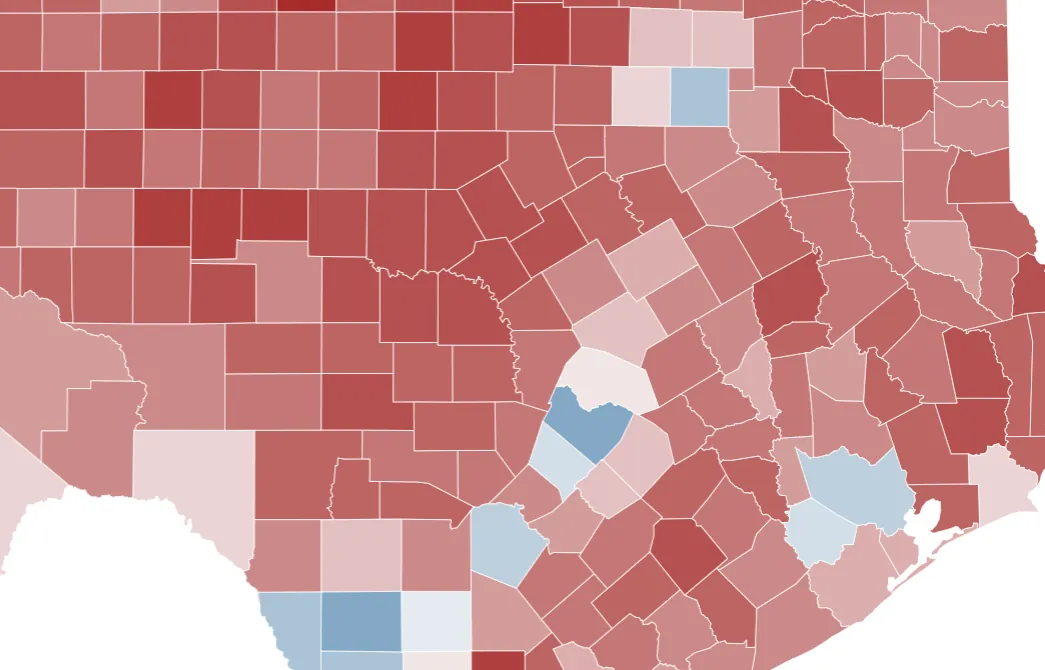Texas has been a Republican stronghold for almost 30 years, with no Democrat winning a statewide office since 1994. However, the margin between Republicans and Democrats has been steadily decreasing in recent years.
In the 2014 race for governor, Greg Abbott secured a resounding victory over Wendy Davis, winning by a wide margin of over 20 percentage points. However, in the more recent 2022 gubernatorial election, Abbott’s margin of victory was noticeably reduced, coming in at around 11 percentage points.
In recent presidential elections, the margin of victory has been incredibly close in Texas. Back in 2012, Mitt Romney managed to secure the state with a slim lead of approximately 16 percentage points. However, in 2016, Donald Trump’s victory was even narrower, with a margin of just 9 percentage points. This trend continued in 2020, as Trump’s margin diminished further to less than 6 percentage points.
What are the reddest and bluest counties?
Democrats have historically found strong support in urban areas such as Austin, Houston, Dallas, and El Paso, as well as in communities in South Texas and the Rio Grande Valley. On the other hand, Republicans have traditionally garnered significant backing in rural regions including the Panhandle, West Texas, and East Texas.
According to reports, the election results from the 2018 and 2022 gubernatorial elections and the 2016 and 2020 presidential elections to determine the average margin of victory in each county. This allowed us to identify the reddest and bluest counties.
Roberts County, located northeast of Amarillo, has been identified as the reddest county in the state. Republican candidates have consistently enjoyed a substantial margin of victory in the past four elections, with an average of 92.86 percentage points.
King County, located between Lubbock and Wichita Falls, has consistently shown strong Republican support, with an average margin of victory of 91.11 percentage points.
In addition to the 19 counties mentioned earlier, there are 45 other counties where Republicans have an average margin of 70 percentage points or higher. Among the counties with more than 100,000 registered voters, Parker County, located west of Fort Worth, stands out as the Republican stronghold. On average, GOP candidates in Parker County secure victory by an impressive margin of 66.86 percentage points.
In contrast, Zavala County, located southwest of San Antonio, stands out with the largest average margin of victory for Democrats. Over the span of six years, from 2016 to 2022, Democratic candidates secured an impressive average lead of 42.64 percentage points.
In addition to Travis County, there are four other counties that have consistently shown strong support for Democrats. These counties include Presidio, El Paso, Webb, and Travis County. Among these, Travis County, which is home to Austin, stands out as the county where Democrats receive the highest level of support. With an average margin of victory of 41.71 percentage points, Travis County demonstrates a significant preference for the Democratic Party among its more than 100,000 registered voters.
Which counties are the closest?
Since 2016, an average of four counties have been determined to have a margin of less than 5 percentage points. Among them, Frio County, located southwest of San Antonio, stands out as the closest with Democrats securing a mere 0.18 percentage point advantage on average.
LaSalle County, located northeast of Laredo, comes in as the next closest county, with Republicans enjoying an average margin of 1.59 percentage points. Following closely is Jim Wells County, situated west of Corpus Christi, where Republicans have an average margin of 2.88 percentage points.
Over the past few cycles, there have been notable shifts in results in several of the counties that are closest based on averages since 2014.
In Hays County, Donald Trump emerged victorious in the 2016 presidential election, defeating Hillary Clinton by a narrow margin of 0.83 percentage points. However, the 2022 gubernatorial election presented a different picture, with Beto O’Rourke securing a significant lead of 11.02 percentage points over Greg Abbott.
Which counties have seen the biggest shifts?
KXAN analyzed the outcomes of the gubernatorial elections in 2014, 2018, and 2022, as well as the presidential elections in 2016 and 2020, in order to ascertain the average change in each county between election cycles.
In recent years, there has been a noticeable shift towards conservatism in several counties, particularly in South Texas. On the other hand, suburban counties have been leaning towards the left.
In Zapata, Kennedy, Foard, Starr, and Duval counties, we have witnessed the most remarkable transformations. With each passing election, Zapata County has consistently shifted towards the right, averaging a change of 10.52 percentage points. Similarly, Kennedy, Foard, Starr, and Duval counties have all experienced significant rightward shifts, with an average change of over 9 percentage points in each election cycle.
Over the years, the Republicans have gained ground in 180 out of the 254 counties in the state, while the Democrats have seen a shift in their favor in 75 counties.
Collin County, located in the DFW Metroplex and home to Plano, has exhibited a considerable leftward shift of 5.77 percentage points in each election cycle, making it particularly noteworthy. Similarly, both Williamson and Hays counties, which are suburbs of Austin, have experienced an average leftward shift of over 5 percentage points per cycle.
Texas has experienced a consistent shift towards the Democratic party at an average rate of 2.37% per election cycle since 2014.
This Article Includes






